Plague: An Ancient and Present Peril
Yersinia pestis
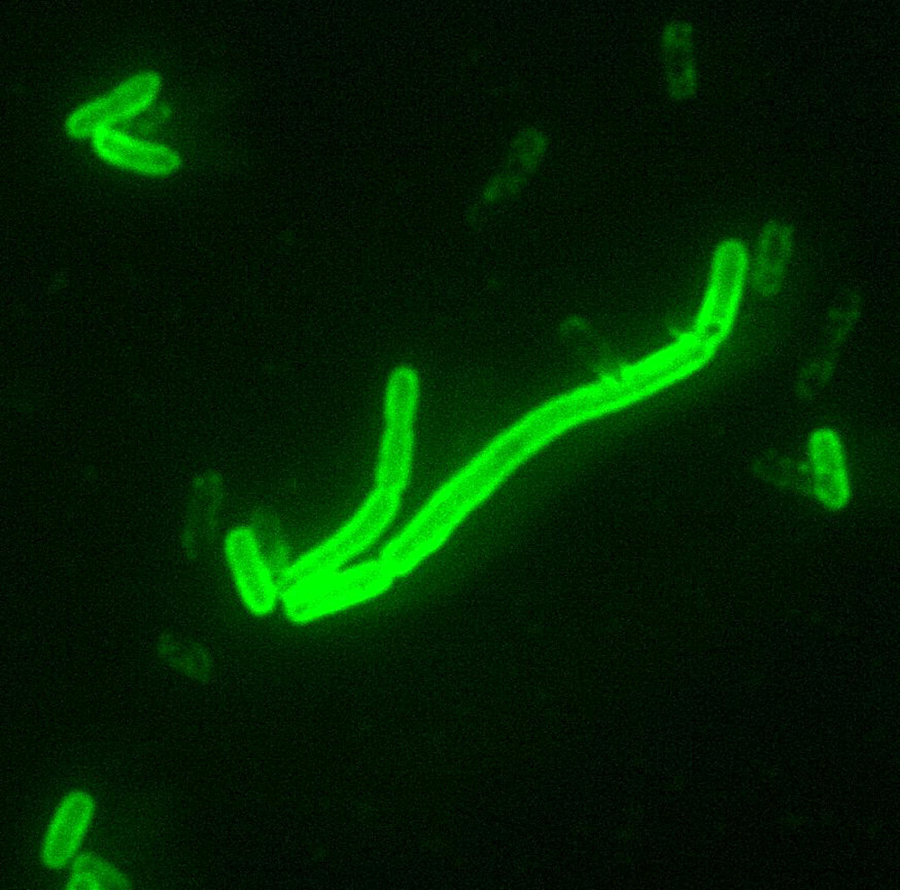
This image shows Yersinia pestis, the bacterium that causes plague, with a Direct Fluorescent Antibody Stain. The image source is the CDC, the U.S. Centers for Disease Control, which allows use of the picture without restriction.
Plague. Black Death. The Peste. Words powerful enough to close a city, seal a house, and spread panic through the countryside. These may be scenes evoked from the history of plague, but plague is by no means consigned to history. It is very much with us today. Health authorities around the world are vigilant in surveillance of outbreaks, because plague as a natural phenomenon, and as a potential instrument of terrorism, is a major concern. This is especially true as antibiotic-resistant strains have appeared in Madagascar. The island nation has experienced outbreaks of pneumonic plague--a particularly virulent form of the disease. Also, despite a concerted effort, no dependable vaccine has been developed.
According to a 2004 report published by the National Academy of Sciences, plague has foci on every continent, except Antarctica and Australia (although Australia did experience outbreaks, at the beginning of the twentieth century).
The map below, published by the CDC, shows the areas in the world where plague episodes were diagnosed between the years of 2000 and 20009. The image is in the public domain.
Pedigree of the Plague
An entomologist at Oregon State University, George Poiner, suggests that rodent strains of Yersinia pestis may have existed long before humans were affected by the disease. He traces the human experience back 10,000-20,000 years. (Other sources suggest 5,000 years may be more accurate). Poiner describes this long ancestry of plague in the context of a puzzling find: a 20-million-year-old flea, preserved in amber. The flea has attached to its proboscis (feeding part) and rectum bacteria that is very similar, virtually identical in shape, to the microorganism that carries plague today.
It is the humble flea that has been indicted over the centuries for delivering this virulent disease to millions--although other vectors and other forms of transmission have been implicated.
Where Did the Plague Come From?
Genetic analysis of Yersinia pestis reveals that it is a close relative to Yersinia pseudotuberculosis, a relatively benign microorganism that can cause diarrhea in humans. Researchers suggests that with two critical mutations, benign Y. pseudotuberculosis became lethal Yersinia pestis. These mutations involved 1) making the bacterium less harmful to the flea, so the insect could be an efficient carrier, and 2) engineering an anti-clotting factor so bacteria could flood the bloodstream of the host as the flea attempted to feed. This anti-clotting mechanism is common in parasites that feed on blood.
Microbiologists guess the critical mutations occurred only a few thousand years ago. A 2016 article in the Journal for the American Society of Microbiology characterizes the change as " a recent evolutionary adaptation". The authors of the article (B. Joseph Hinnebusch, Iman Chouikha and Yi-Cheng Sun) refer to studies that trace Y. pestis back to the Bronze Age, some four to five thousand years ago. This research indicates that the plague originated in Central Asia.
There is research that suggests Bronze Age plague may not have been spread by fleas.
There Are Three Types of Plague: Bubonic, Pneumonic and Septicemic
The bubonic plague is what most people think of when they hear about plague. This is spread generally by fleas and is characterized by hugely swollen lymph glands. Pneumonic plague settles in the lungs and is spread person-to-person, through coughing and sneezing. Septicemic plague is an infection of the blood. It may be contracted from the bite of an infected insect or animal, direct contact with a contaminated source, or it may be secondary to untreated bubonic plague.
Although the flea has been a notorious vector for plague, other ectoparasites (lice, for example) have been implicated. The flea most commonly associated with plague transmission is Xenopsylla cheopis, but other flea species, especially Oropsylla montana, also transmit the disease. It has been suggested that Oropsylla montana may be the primary vector for plague transmission in North America.
Xenopsylla cheopis
This image of a flea infected with Yersinia pestis was taken by Dr. Pratt of the CDC. The image is in the public domain. What the image shows is a flea engorged with blood. In this state the flea is unable to feed. It attempts to draw blood from a host, by inserting its proboscis, but the passage is blocked so no food can pass. The flea is starving, so it repeatedly attempts to feed. With each attempt, it regurgitates bacteria-loaded saliva into the wound it has just made. The bloodstream of the host is thereby flooded with Y. pestis. The flea may go from host to host repeating this exercise. The preferred meal for this flea is rat blood, but a starving flea will lunch on any available warm-blooded mammal, if a rat is not nearby. According to the caption that came with this picture, it took thirty days after infection with the bacterium for the flea to reach this stage of extreme engorgement. (More about how fleas may infect hosts later in this blog.)
Plague Pandemics
History offers a record of three plague pandemics. The first one, known as the Justinian Plague (541 AD) originated in Egypt and spread through the Byzantine Empire. As was true for many contagions, the plague traveled with the army--and with grain. The point of entry for plague in a country has historically been a port. Ships typically carried unintended cargo, infected rats and their fleas. From this entry point, the contagion spread through the port, then to the countryside. Often, disease was a gift carried by those who fled from epidemic plague in the city.
The Emperor Justinian and His Court
This mosaic shows the Emperor Justinian (483-565) with members of his court. The mosaic is located today at the MET. It is used under a CC0 Universal Public Domain license.
The Justinian Plague reportedly began with the conquest of Vandals in Egypt by the Emperor Justinian. The plague, according to a contemporaneous account from the Byzantine historian, Procopius, first entered Constantinople in 491 AD, as soldiers returned from the field. The disease killed without regard for gender, age or station. Some estimates place the number of dead at 10,000 a day. Procopius describes an illness that "embraced the entire world". Several sources suggest that half the population of Europe perished in this pandemic. The geographic reach of the contagion, recent grave excavations suggest, included parts of Germany.
The Justinian Plague endured for 250 years.
The Black Death: The Second Pandemic (Mid 14th to Mid 18th Centuries)
This 1375 drawing by Abraham Cresques shows a caravan on the Silk Road. The picture is from the Catalan Atlas and is in the public domain because its age.
Most historians believe this pandemic originated in China. It seems to have traveled along the Silk Road, which had been re-opened by Kublai Khan (1215-1294) after centuries of relative disuse. This Chinese Emperor (of the Yuan Dynasty) brought peace to the trade route and thus facilitated traffic. The caravans on the Silk Road were convenient transports for stowaway rats. Outbreaks of plague in centuries that followed tended to occur along trade routes.
A popular name for the Second Pandemic was the Black Death. The disease earned this name because of the black blotches that appeared under the skin, caused by hemorrhaging blood, and because of the discoloration of limbs that often became gangrenous.
Just as Procopius had described the Justinian plague for posterity, so too did Boccaccio give to posterity a vivid impression of the Black Death's ghastly toll. "...it is believed for certain that upward of an hundred thousand human beings perished within the walls of the city of Florence," Boccaccio states. He describes the inundation of corpses into churchyard graves until, "...vast trenches (were dug), wherein those who came after were laid by the hundred and being heaped up therein by layers, as goods are stowed aboard ship, were covered with a little earth, till such time as they reached the top of the trench". During the Second Pandemic, the death toll may have reached 60% of the total population of Europe. The plague also wiped out a large portion of the population of China.
The drawing is from the classic novel Journal of the Plague Year (though some critics believe the book should be classified as nonfiction) by Daniel Defoe (1660-1731). Defoe was five when the plague hit London, so his account, published in 1722, is not based on observation or memory. It is based, however, on the diary of a survivor, Samuel Pepys. The drawing shows plague victims being carted off to mass graves. This image is in the public domain because of its age.
The Second Pandemic is said to have lasted only twenty-five years, but in actuality the plague kept reappearing with ferocity, and exacted appalling death tolls throughout Eurasia for several hundred years.
The Third Pandemic
The Third Plague Pandemic began in China in 1855 and lasted until 1959. It is estimated to have killed fifteen million people, with the greatest loss of life occurring in India and China. It was during the Third Pandemic that Yersinia pestis was identified by a French doctor, Alexandre Yersin, in 1894. Yersin also recognized the association between rats and the disease. What was still missing was the mode of transmission. That piece of the puzzle was discovered by Paul-Louis Simond in 1898, when he identified the flea as the connection between the rat and human infection.
It is interesting that Yersin and Simond were working with plague victims when they made their discoveries. Yersin was working in Hong Kong and Simond was working in Karachi.
Plague Reservoirs
Animal reservoirs for plague have long been recognized. These include especially (besides the rat) ground-dwelling mammals such as prairie dogs and squirrels. Animals that are not ordinarily reservoirs can be infected when they eat an infected animal. Domestic animals, such as dogs and cats, can carry plague-infected fleas home. (Cats are particularly susceptible to this peril). All of these factors help to explain easy transmission and dogged persistence of plague. There is, however, another reservoir that has not traditionally been a popular focus for research: soil. Several studies have implicated soil as a reservoir for plague.
White-Tailed Prairie Dog
![White-tailed_prairie_dog_2[1].jpg](https://steemitimages.com/DQmeJhNUPFRJn4ULtzoL6frfUW9fVAMKxQhChSUtYTQoF5V/White-tailed_prairie_dog_2%5B1%5D.jpg)
This picture was taken for the National Biological Information Infrastructure Project of the United States Geological Survey's Biological Informatics Office. The image is in the public domain.
One of the most recent and persuasive studies that proved the ability of Y. pestis to thrive in soil was conducted in Northern Africa. The researchers who carried out this study (Maliya Alia Malek, Idir Bitam, Anthony Levasseur, Jerone Terras, Jean Gaudart, Said Azza, Christopher Flauddrops, Catherine Robert Didier Raoult and Michel Drancourt) posit in their report that animals are infected with Y. pestis when they come in contact with contaminated soil. They describe one rodent burrow where viable Y. pestis was present years after rodents had abandoned the spot. The study finds a correlation between long-term survival of Y. pestis and soil that is highly saline. Earlier studies had shown the ability of Y. pestis to remain virulent in soil for up to 40 weeks, without regard to salinity.
Yersinia Pestis: Up Close
The persistence of Y. pestis over the centuries can be explained partly by its mutations, which made the flea an efficient delivery system. It can be explained partly by its ability to exist without an animal host, in soil. There are other factors that make this microorganism a formidable opponent. Some of those will be reviewed here.
Temperature Tolerance
Different strains of Y. pestis show varied tolerance to temperature. Transmission of disease was demonstrated at temperatures between 50º and 86º F (10º and 30º C). In the studies that demonstrated this tolerance, it was the survival of the flea, and not Y. pestis, that was threatened. There have been studies that have shown Y. pestis cannot only exist, but can multiply at 39.2º F (4º C), "with the proper nutritive requirements".
Ability to Survive in Anaerobic and Aerobic Environments
Y. pestis is a facultative anaerobe. This means it prefers an environment without oxygen, but it can adjust to one that has oxygen. This flexibility gives it a greater shot at surviving in a variety of circumstances.
Formation of Biofilms
Earlier in this blog I featured the image of a flea that was engorged with blood. I explained that this engorgement meant the flea would starve and that it would regurgitate, in futile attempts to feed. By doing so, it would pour contaminated saliva into a host. What I didn't discuss is how this engorgement occurred. It is through Y. pestis formation of biofilms that the ability of the flea to receive food is blocked. The biofilm (as discussed in my blog The Universe of the Intelligent Microbe), is a community of bacteria that is encased in a gelatinous mass. The mass is virtually impenetrable and acts as a plug in the flea's feeding tube. No food will get through.
Y. pestis also forms biofilms on surfaces. This allows the bacteria to resist attack and also to invade other organisms more effectively.
Yersinia Pestis Forming Colonies in Sheep Blood Agar

The image is from the CDC's Public Health Library. It is available without restriction to the public.
Early Phase Transmission of Yersinia pestis From a Flea Vector
Classically, transmission of plague occurs when an infected flea cannot feed and regurgitates into a host's wound. Recent research has shown that fleas can be efficient plague vectors before formation of a biofilm. If a flea feeds off an infected animal, and then proceeds to feed on another mammal within a week, it can transmit the newly acquired bacteria. This is called early phase transmission and it is believed this may explain the rapid spread of plague in some epizootics (epidemic outbreak among animals).
*Co-existence, and Replication in Amoeba
This finding, by a US research team from New Mexico and Colorado, helps to explain the survival of Y. pestis between epizootics. The scientists looked at amoeba they collected from a prairie dog burrow in Colorado. They found in one variety of amoeba, D. discoideum, the presence of Y. pestis. The bacterium not only survived, but replicated. In four other varieties of amoeba researchers discovered less viability, but some tolerance. The authors suggest that over time the weak tolerance of Y. pestis by these amoeba species may evolve, so that these also can become a dependable reservoir for the pathogen.
Summary
Y. pestis presents a significant public health concern. Although, for most people in the world this is one of those threats that receives little attention, the potential for a major crisis exists. The disease is highly virulent, especially in its pneumonic form. In this manifestation of plague, if treatment is not commenced within 24 hours, death is certain.
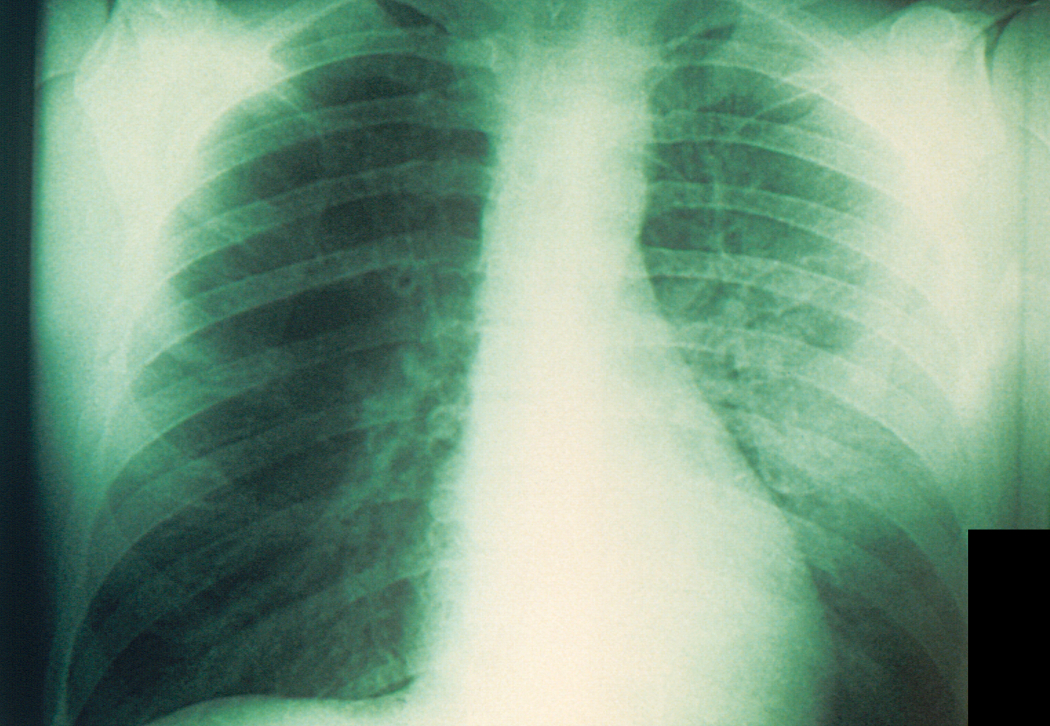
This image of a plague-infected lung was taken by Dr. Jack Poland for the CDC in 1975. The image is stored in the CDC's Public Health Library, which is open for use by the public, without restriction.
For comparison, this is what a normal lung would look like:
_chest_radiograph_(X-ray)Mikael%20H%C3%A4ggstr%C3%B6m%20CC0.jpg)
This image was taken by Mikael Haggstrom and is offered without restriction to the public on a CC0 license.
Some strains of Y. pestis (isolated in the current Madagascar outbreak) have demonstrated antibiotic resistance. According to an article published in the International Journal of Antimicrobial Agents, a multi-drug resistant strain is not only a very real possibility, but also would present "a major health threat".
Even with the availability of effective treatment, in the case of an epidemic, public health resources could be overwhelmed. Panic is a very real possibility, and this would interfere with an effective public health response. A case study of this might be seen by looking at what happened in the 1994 Surat plague outbreak in India. According to a report published by the Entomology Group at Montana State University, people fled the city and carried the infection into the countryside. Tetracycline, which was used to treat the disease, rapidly disappeared from healthcare facilities and pharmacies. The military had to be called in, to enforce a quarantine. In the end, the Surat outbreak claimed 56 lives.
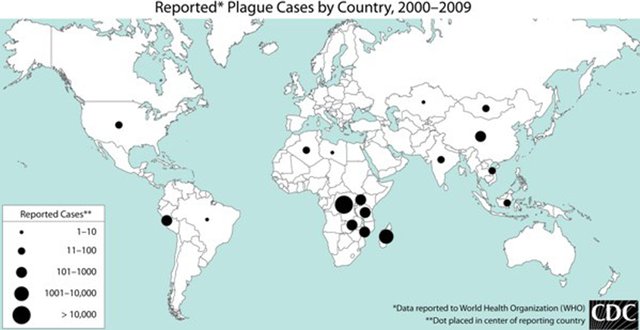
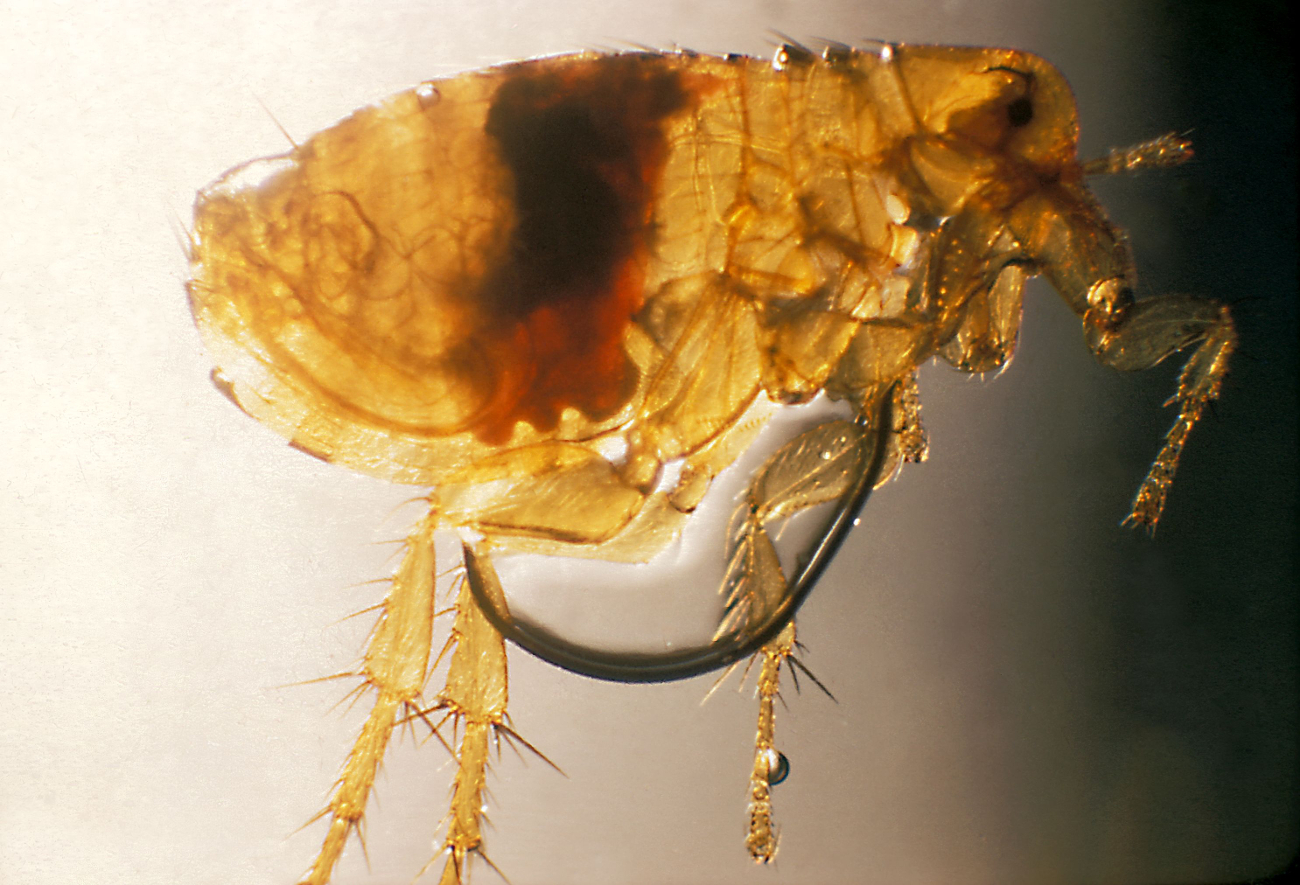

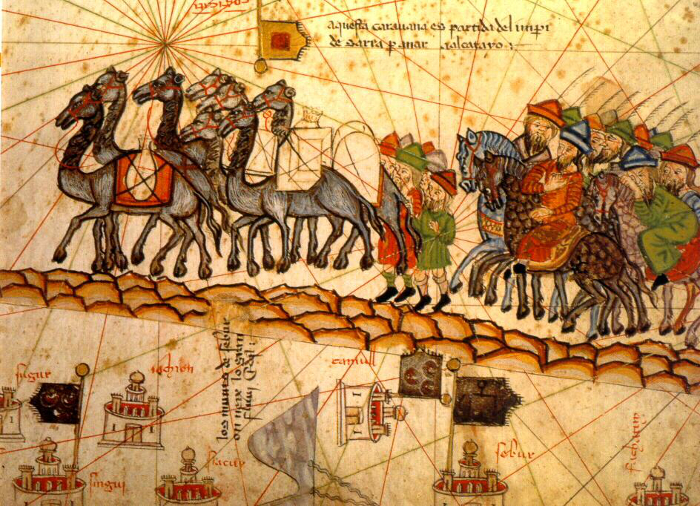
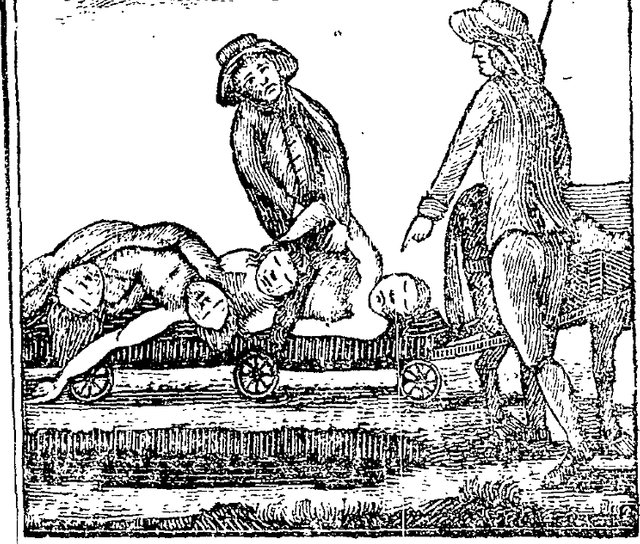
Every once in a while, a student in the metagenomics course I help with gets a read or two of Y. pestis in their environmental sample, recognizes it, and flips out.
It's a great teachable moment when we get to talk about OTU identification, the fact that it's 1 read in millions, infectivity, strains, and a bunch of different things.
I would flip out...great that you have the composure to exploit the experience. I'm impressed--always by your blogs, and by your knowledge.
"Ring around the rosies, pocket full of posies...
Namaste, JaiChai
I thought about including that...it was actually hard reading some of the descriptions, though they weren't new to me.
Thank you for your kind greeting, and I return it.
An erudite and informative essay on a much too soon forgotten health threat. I’d resteem it, if I could, but the option seems to be disabled. I shared it to my FB and Twitter feeds, though.
Thank you! Every time I write one of these long-form blogs it's like going back to school. I start thinking I know something and then keep following tangents. Rewarding to have the work appreciated.
I always appreciate a learning mind.
:)
it is indeed an educative post for me as a student, i learnt from it. i had usually come across the term plague whenever deadly diseases that have gruesomely affect the human race.now i know its histroy and pathogenicity.
also i share the same opinion about creating awareness corncerning this disease.thanks for this wonderful post......
Thank you so much. I will be following you to see what you have to say. Welcome to Steemit.
You received a 60.0% upvote since you are a member of geopolis and wrote in the category of "ecology".
To read more about us and what we do, click here.
https://steemit.com/geopolis/@geopolis/geopolis-the-community-for-global-sciences-update-4
Thank you!
It's good to be reminded sometimes that we are lucky to live in modern times. The most effective diseases seem to keep their hosts alive for a relatively long time. Pretty grim how the flea stays alive but can't feed
I know. As I research microorganisms and their vectors, I become aware of competing life forms. People worry about invasions from outer space. The enemy more likely lives among us. This is a determined enemy, flexible and smart. We'd definitely be better off if we dedicated resources to understanding and combating that, instead of expending life and treasure going to war with each other.
Thanks for this important update. @agmoore
Thank you!
Congratulations @agmoore! You have completed some achievement on Steemit and have been rewarded with new badge(s) :
Click on any badge to view your own Board of Honor on SteemitBoard.
To support your work, I also upvoted your post!
For more information about SteemitBoard, click here
If you no longer want to receive notifications, reply to this comment with the word
STOPThank you!
The emergence of antibiotic resitant strains of plague was a worrying development last year. I think that influenza is more likely to be a primary disease of concern, but in a population already stressed by a flu outbreak, diseases like plague, typhoid, cholera and ebola could find their way into the population as sanitation and infrastructure break down.
It's hard to know where the next pandemic will come from, or what it will be. One thing is certain, this is a danger that has always been with us. Vigilance, sanitation, research and education are the best defenses.
I don't think it's a competition between plague, Ebola, typhoid, etc. Ebola and flu certainly have gained public attention. Plague is really off the radar for most people. Recent outbreaks in Peru, Madagascar, the Congo, etc...are warning flags. This is a foe we haven't really beaten. It kills about 3,000 every year. Not only is plague a potential peril, it also is an interesting subject. The history of the disease takes us back through time.
Oh, I doubt it would be a competition. They all would be a risk in the right conditions. Not to mention others that are rarely seen now.
There are cases in the US every year from squirrels and groundhogs, mole carry it in Europe. No, it has not disappeared and is just sitting pretty waiting for the right conditions to really get going.
Yeah, it was actually kind of creepy writing this, as the blog progressed. I started it as an academic exercise and then the sheer weight of suffering got to me--even the picture if an expiring squirrel. Next blog won't have so much suffering in it.
Yeah. I have always been fascinated and repelled in equal measure by infectious disease and plagues.
The scariest proposition is pneumonic plague that is resistant. That will really test things.
There have been a few interesting outbreaks of ebola type viruses not commonly known also.
I think in a way, by studying the diseases we get a handle on our revulsion (sort of a reaction formation). Gives us a sense of control to understand the thing that repels us. You obviously have given the subject some thought also. A lot of people just look away. One reason I wrote the blog. Of course, if no one reads it, I haven't accomplished much, have I :)
Mind you, the world could do with a decent plague. Wars cull the strong and able, disease hits the weaker and least immune. So for population control it is preferable. However, it would be nice just to see resources devoted to enabling the population as it stands, instead of spending so much time, energy and resources on war.
I've finally had two cups of coffee and so can begin to operate on Steemit. All fuses are nonfunctional before coffee.
Your comment is likely intended to be provocative, but as I grow older I'm not so easily surprised or provoked. What I will offer in response is a couple of thoughts:
War and plague are unpredictable agents of those who employ them. They can be indiscriminate in operation, and turn upon those who unleash them (see: Russian nobility and WWI).
Both agents of death, however, do have in common one consequence: they generally fall most heavily on the poor, who have less resources to escape or resist them. This is true of the present plague epidemics. As epidemiologists look for risk factors, they cite low socioeconomic status. And, as we know, wars are often fought by those with limited political and economic resources (see: Vietnam in the US).
I think if we are looking to control population growth, we might try raising living standards. It seems that the more secure people feel, the less children they have. The theory to explain this is that more than one or two offspring are not essential for gene survival (see: birth rates in Norway).
You see, coffee works. Perhaps the mind is not working effectively, but it is working :)